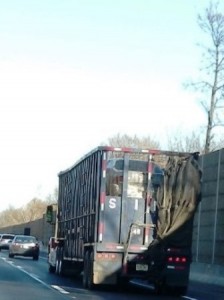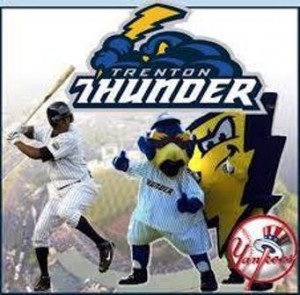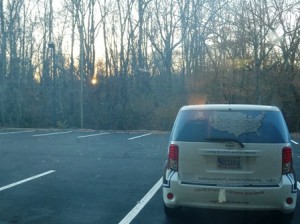» posted on Wednesday, November 13th, 2013 by Linda Lou Burton
Bird In A Cage
 Linda Burton posting from Trenton, New Jersey – Oh the horror! From the wide-open farmlands of the Pennsylvania Dutch to the narrow confines of the Pennsylvania Turnpike; cornfields to concrete; shock. I was willing to pay for good road to move me swiftly across the state to New Jersey. But I told the toll-taker on my exit near Morrisville, “You really should pay me to ride on this horrid road.” He took my $5.75 without comment. I’d felt confined the whole way, barriered in from any scenery; tunnelized; I longed for anything else. Route 1 turned out to be even worse; no sign welcomed me to New Jersey as I whizzed over the
Linda Burton posting from Trenton, New Jersey – Oh the horror! From the wide-open farmlands of the Pennsylvania Dutch to the narrow confines of the Pennsylvania Turnpike; cornfields to concrete; shock. I was willing to pay for good road to move me swiftly across the state to New Jersey. But I told the toll-taker on my exit near Morrisville, “You really should pay me to ride on this horrid road.” He took my $5.75 without comment. I’d felt confined the whole way, barriered in from any scenery; tunnelized; I longed for anything else. Route 1 turned out to be even worse; no sign welcomed me to New Jersey as I whizzed over the  Delaware River; my only clues were the dotted lines on the GPS, and a blur to my left that said Trenton Makes. Makes what? Eight miles beyond the river, the GPS advised me to take Mall Access Road; I followed that advice. No hotel, just Macy’s, and Sears; it took a while to realize that my hotel was on the other side of Route 1. There are no left turns off said highway, only concrete barriers. You must pass your intended destination, take a right at the next overpass, cross over Route
Delaware River; my only clues were the dotted lines on the GPS, and a blur to my left that said Trenton Makes. Makes what? Eight miles beyond the river, the GPS advised me to take Mall Access Road; I followed that advice. No hotel, just Macy’s, and Sears; it took a while to realize that my hotel was on the other side of Route 1. There are no left turns off said highway, only concrete barriers. You must pass your intended destination, take a right at the next overpass, cross over Route  1, and head back the other way. Three lanes of traffic going both ways; no dedicated lanes to feed into; non-stop New Jersey drivers, all as frustrated as me. Or maybe more. By the time I reached my hotel, the morning pleasantness I’d felt at Bird-In-Hand had turned to the dismay of a bird in a cage. “You’d better get used to me,” I said to the cats after I unloaded the car. “I won’t be going out much.” I opened the laptop, and plugged in a search for “Trenton,” the Journey’s Capital City #48.
1, and head back the other way. Three lanes of traffic going both ways; no dedicated lanes to feed into; non-stop New Jersey drivers, all as frustrated as me. Or maybe more. By the time I reached my hotel, the morning pleasantness I’d felt at Bird-In-Hand had turned to the dismay of a bird in a cage. “You’d better get used to me,” I said to the cats after I unloaded the car. “I won’t be going out much.” I opened the laptop, and plugged in a search for “Trenton,” the Journey’s Capital City #48.
 A bit of trivia caught my eye; Trenton is one of only two capital cities that border another state; Carson City, Nevada is the other (bordering California). I daresay many who work in Trenton live on the other side of the Delaware River in Pennsylvania; in fact, my Dad did that for a while, back in the 60s. He and Mom had a house on the Canal in Morrisville; he complained about the 10-cent toll he had to pay every time he crossed the bridge into Trenton to go to work at Atlantic Bag. I see there are several bridges crossing over – the Trenton-Morrisville
A bit of trivia caught my eye; Trenton is one of only two capital cities that border another state; Carson City, Nevada is the other (bordering California). I daresay many who work in Trenton live on the other side of the Delaware River in Pennsylvania; in fact, my Dad did that for a while, back in the 60s. He and Mom had a house on the Canal in Morrisville; he complained about the 10-cent toll he had to pay every time he crossed the bridge into Trenton to go to work at Atlantic Bag. I see there are several bridges crossing over – the Trenton-Morrisville  Toll, the Lower Trenton Bridge, and the Calhoun Street Bridge. Washington Crossing Historic Park is not far from Morrisville and Trenton; we visited there and Dad took my sons fishing on the Canal; I seem to remember something about mule-drawn barges too. We attended a play at the Bucks County Playhouse, and went antiquing; I mention this only because this is likely a part of the lifestyle of the area even though the activities are in different states.
Toll, the Lower Trenton Bridge, and the Calhoun Street Bridge. Washington Crossing Historic Park is not far from Morrisville and Trenton; we visited there and Dad took my sons fishing on the Canal; I seem to remember something about mule-drawn barges too. We attended a play at the Bucks County Playhouse, and went antiquing; I mention this only because this is likely a part of the lifestyle of the area even though the activities are in different states.
My laptop pulled up some facts. The population within the eight square miles that make up Trenton proper is 84,913 (US Census 2010), making it the 33rd most populous capital city; Albany, New York and Santa Fe, New Mexico are similar in population. But the metro area of  Trenton takes some wild swings; is it part of New York City, or Philadelphia? Trenton is almost in the center of the state; sometimes it is considered part of “North Jersey,” and the southernmost city of the Tri-State region including New York and Connecticut. It also is considered by some as “South Jersey,” and the northernmost city of the Delaware Valley! Locals, however, call it “Central Jersey.” How do sports loyalties run, with the choices of Phillies, Eagles, 76ers, Union, Flyers, Yankees, Mets, Nets, Knicks, Rangers, Jets, Red Bulls, Giants, and Devils? There is the Trenton Thunder for local, a Double-A minor league team affiliated with the New York Yankees; they play at Plumeri Field in Trenton.
Trenton takes some wild swings; is it part of New York City, or Philadelphia? Trenton is almost in the center of the state; sometimes it is considered part of “North Jersey,” and the southernmost city of the Tri-State region including New York and Connecticut. It also is considered by some as “South Jersey,” and the northernmost city of the Delaware Valley! Locals, however, call it “Central Jersey.” How do sports loyalties run, with the choices of Phillies, Eagles, 76ers, Union, Flyers, Yankees, Mets, Nets, Knicks, Rangers, Jets, Red Bulls, Giants, and Devils? There is the Trenton Thunder for local, a Double-A minor league team affiliated with the New York Yankees; they play at Plumeri Field in Trenton.
So what about the early days? How did this city by the Delaware River get its name? I looked under “history.” Mahlon Stacy was leader of a group of Quakers who settled here in 1679; religious freedom their goal; the region then was called the Falls of Delaware. Over the years,  a Scottish fur trader and merchant by the name of William Trent purchased much of the land in the area from the Stacy family. He platted a town around his house which came to be known as Trent’s Towne; later it was shortened to Trenton. Trent became active in New Jersey politics, and was elected to the Assembly, commissioned a Colonel of one of the militia regiments and in 1723, appointed as New Jersey’s first resident chief Justice. On Christmas Day, 1724, William Trent died suddenly from a “fit of apoplexy,” or what we might today call a stroke; his burial site is unknown.
a Scottish fur trader and merchant by the name of William Trent purchased much of the land in the area from the Stacy family. He platted a town around his house which came to be known as Trent’s Towne; later it was shortened to Trenton. Trent became active in New Jersey politics, and was elected to the Assembly, commissioned a Colonel of one of the militia regiments and in 1723, appointed as New Jersey’s first resident chief Justice. On Christmas Day, 1724, William Trent died suddenly from a “fit of apoplexy,” or what we might today call a stroke; his burial site is unknown.
You’ve seen the famous portrait by Emanuel Leutze, Washington Crossing the Delaware, where General George Washington is portrayed leading his troops across the icy Delaware  River. The actual event took place December 26, 1776 and was Washington’s first move of the Revolutionary War; a surprise attack against Hessian forces garrisoned at Trenton; Hessian officers occupied the William Trent house at the time. Washington and his troops defeated the British at the “Battle of Trenton” and, well, you know the rest of the story. Did you know that Trenton was the national capital of the United States? It was, for a brief period in November and December, 1784. It was considered as a location for the permanent capital for the new country, but southern states favored a location south of the Mason-Dixon line.
River. The actual event took place December 26, 1776 and was Washington’s first move of the Revolutionary War; a surprise attack against Hessian forces garrisoned at Trenton; Hessian officers occupied the William Trent house at the time. Washington and his troops defeated the British at the “Battle of Trenton” and, well, you know the rest of the story. Did you know that Trenton was the national capital of the United States? It was, for a brief period in November and December, 1784. It was considered as a location for the permanent capital for the new country, but southern states favored a location south of the Mason-Dixon line.
Trenton has been New Jersey’s capital since November 25, 1790, although the Legislature often met in Trenton prior to that. (New Jersey became the third state December 18, 1787.) The town was incorporated in 1792, and grew steadily; Europeans came to work in the pottery and wire rope mills. Ah, there it is! Trenton Makes. The World Takes. The phrase  popped up on my computer screen; this city motto was adopted in 1917 to represent Trenton’s leading role as a major manufacturing center for that wire rope, and pottery, as well as rubber. Wire rope? Think suspension cables, like the Brooklyn Bridge, and the Golden Gate. Ceramics? Do you have any Lenox china in your cupboard? (I do.) Walter Lenox began his company in 1889; Lenox world headquarters is on Princeton Pike today. Rubber? Trenton once was known as the “nation’s tire capital;” think cars, after 1900. At one time there were 18 rubber factories in the area.
popped up on my computer screen; this city motto was adopted in 1917 to represent Trenton’s leading role as a major manufacturing center for that wire rope, and pottery, as well as rubber. Wire rope? Think suspension cables, like the Brooklyn Bridge, and the Golden Gate. Ceramics? Do you have any Lenox china in your cupboard? (I do.) Walter Lenox began his company in 1889; Lenox world headquarters is on Princeton Pike today. Rubber? Trenton once was known as the “nation’s tire capital;” think cars, after 1900. At one time there were 18 rubber factories in the area.
During Trenton’s history, its factories have produced paper, violins, buttons, leather belting, frying pans, nails, and carriages. This “city by the falls” between New York and Philadelphia was a perfect location for cotton mills, distilleries, tanneries, and iron works – beams for the dome on the US Capitol came out of Trenton. But, along with many other US cities, Trenton suffered as manufacturing and industrial jobs declined in the 1970s. The population has been in steady decline since 1950; of those who continue to live within the Trenton city limits, 26%  are below the poverty level. Trenton’s biggest employer now is state government; about 20,000 state workers enter the downtown area every workday from surrounding suburbs.
are below the poverty level. Trenton’s biggest employer now is state government; about 20,000 state workers enter the downtown area every workday from surrounding suburbs.
That explains it. The traffic on Route 1! The unforgiving barriers, the No Left Turns. Rush in; rush out. Route 1 runs from Key West, Florida to Fort Kent, Maine and the Canadian border; 66.06 miles of it are in New Jersey. It enters the state as I did – from Morrisville, Pennsylvania into Trenton – and leaves at the George Washington Bridge over the Hudson River. The piece near Trenton began as the Trenton-New Brunswick Turnpike in 1803; various legislations  and permutations have changed and added to that. In the 1990s traffic lights were removed and replaced with overpasses; projects intended to alleviate traffic and make the roadway safer. Yet in 2013, the road (along with two others) made the #1 ranking on the list of “top ten most dangerous roads for pedestrians” in New Jersey, New York, and Connecticut.
and permutations have changed and added to that. In the 1990s traffic lights were removed and replaced with overpasses; projects intended to alleviate traffic and make the roadway safer. Yet in 2013, the road (along with two others) made the #1 ranking on the list of “top ten most dangerous roads for pedestrians” in New Jersey, New York, and Connecticut.
 It was almost dark; the last glimmer of sunlight peeped between bare trees in the woods outside. On the other side of the hotel, non-stop traffic kept a steady drone. There is no back-road to safer city streets; the hotel driveway opens directly onto Route 1. There is no traffic light, just three lanes of cars pushing the speed limit; even worse, the right lane is the entry ramp for I-95, and points I don’t want to go; it is imperative to get to the center lane immediately. Route 1 is not conducive to leisurely sightseeing; it doesn’t invite exploration of this historic city. “I really am a bird in a cage,” I sighed, looking over at Alex and Jack, now snoozing peacefully on their red blankie. “I guess I’ll be doing a lot of reading while we’re here.”
It was almost dark; the last glimmer of sunlight peeped between bare trees in the woods outside. On the other side of the hotel, non-stop traffic kept a steady drone. There is no back-road to safer city streets; the hotel driveway opens directly onto Route 1. There is no traffic light, just three lanes of cars pushing the speed limit; even worse, the right lane is the entry ramp for I-95, and points I don’t want to go; it is imperative to get to the center lane immediately. Route 1 is not conducive to leisurely sightseeing; it doesn’t invite exploration of this historic city. “I really am a bird in a cage,” I sighed, looking over at Alex and Jack, now snoozing peacefully on their red blankie. “I guess I’ll be doing a lot of reading while we’re here.”
 I got up from my desk and headed for the coffeepot; right beside it sat the box of Whoopie Pies I’d bought earlier in the day.
I got up from my desk and headed for the coffeepot; right beside it sat the box of Whoopie Pies I’d bought earlier in the day.
